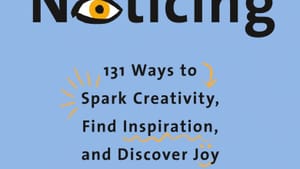Stay in the Loop
BSR publishes on a weekly schedule, with an email newsletter every Wednesday and Thursday morning. There’s no paywall, and subscribing is always free.
Readers on notice
‘The Art of Noticing’ by Rob Walker

It may seem that giving up or giving in or giving over are the only ways to cope now. But there is something else, and it’s not that hard: noticing. Rob Walker’s book, The Art of Noticing, is a perfect companion for quarantine—and whatever comes next.
Noticing is more than looking. It’s inordinately easy to gloss over what’s around us. Technology pushes so many things at us that we often feel bombarded, pressured to either accept all that stuff or ignore it completely. But Walker has crafted an inviting book that helps alleviate some of the fuzz.
Slowing down instead of cleaning up
“In this age of distraction [with] our lives in constant tether to phones, to email, and to social media,” Walker believes we can lose the ability to pay attention. The Art of Noticing: 131 Ways to Spark Creativity, Find Inspiration, and Discover Joy in the Everyday is his prescription and antidote. Unlike Marie Kondo, he’s not asking us to clean up our act or closet or bookshelf. He’s just asking that we slow down a bit.
When you’re overwhelmed, sometimes it’s best to take a break. That’s the aim of this book, and because Walker is also a design expert, its lovely tactile feel, friendly cover, and whimsical yet pungent illustrations make you want to pick it up and open it. You don’t have to go from front to back, or start to finish, or actually in any direction at all. Just crack it open and try one of this author’s thoughtful prompts.
Something everyone can do
Walker introduces the book by citing a few (in the words of Saul Bellow) “first-class noticers,” people who see (or saw) things that others overlook. They include Billy Beane (baseball sabermetrics guru), Rachel Carson (legendary environmentalist), Warren Buffet (expert in undervalued companies), and Jerry Seinfeld (finding the absurd everywhere every day).
Noticing is something everyone can do. The Art of Noticing has five sections of tasks designed to refresh and renew. Each activity is ranked with “eye-cons” according to four degrees of difficulty. The first is “So easy: anybody can do this right now;” next is “Doable: may take some planning or thought but it’s nothing you can’t handle.” The third level is “Enjoyably challenging: you’ll make the effort but it will be worth it,” and for the truly committed, “Advanced: noticing has become an adventure.”
So far, I’ve limited myself to the easiest ones. In “Looking” (the first chapter), Walker suggests you “spot something new every day” in familiar places. It’s a visual reset, “no tools required,” with surprising results. I found a new floral design in my living room curtains and some remarkably interesting floorboards. Another suggestion here is to “take a color walk,” but I boldly modified that by picking up Kassia St. Clair’s Secret Lives of Color and reading about a new color.
What and when
For the (hopefully) near future, a section on “What to look for when you’re in a museum” includes easy tasks like watching the guards, studying everything except the art, or looking for flaws. The book overflows with art-related quotes and anecdotes, and here Walker cites a “noticing project” by omnivorous artist Nina Katchadourian. She says her job is to “pay attention and see what’s there that we haven’t seen yet.” She became fascinated by the places where dust gathered (and who cleans it) in New York’s Museum of Modern Art.
In “Sensing” (Chapter 2), Walker suggests that you “change the time scale.” Look for the oldest thing around you, then for the newest thing. Consider what they share and what sets them apart and which will outlast the other. Another exercise is based on composer John Cage’s 4’33”, a three-movement work that consists of silently opening and closing a grand piano lid three times. Set your phone timer (okay to use technology here), close your eyes, and listen for four minutes and 33 seconds of possible auditory surprises.
Unitasking
Some exercises in “Going Places” (Chapter 3) and “Connecting with Others” (Chapter 4) must be saved for the future, but a surprising amount involve things to accomplish even in this time of restrictions. And Chapter 5, “Being Alone,” is almost perfect for now. You can “unitask.” While “there’s nothing wrong with watching Netflix while folding clothes,” Walker asks that you give your undivided attention to one mundane thing at a time. And my favorite prompt is in this chapter: “Study a rock.” This involves looking at a stone for five minutes, a meditative mindfulness exercise that is not nearly as simple or silly as it might seem. Flaubert was right: “Anything becomes interesting if you look at it long enough.”
Walker—author of three other books and many articles in major periodicals—published this volume in 2019, but it seems so totally apt as to be an exercise in futurism. Somewhere between “tasks” and “meditations,” these activities are designed to refresh and renew, some of them so simple that (like Zen philosophy) they are actually profound.
What, When, Where
The Art of Noticing. By Rob Walker. New York: Alfred A. Knopf, 2019. 238 pages, hardcover. Get it here.
Sign up for our newsletter
All of the week's new articles, all in one place. Sign up for the free weekly BSR newsletters, and don't miss a conversation.

 Gail Obenreder
Gail Obenreder